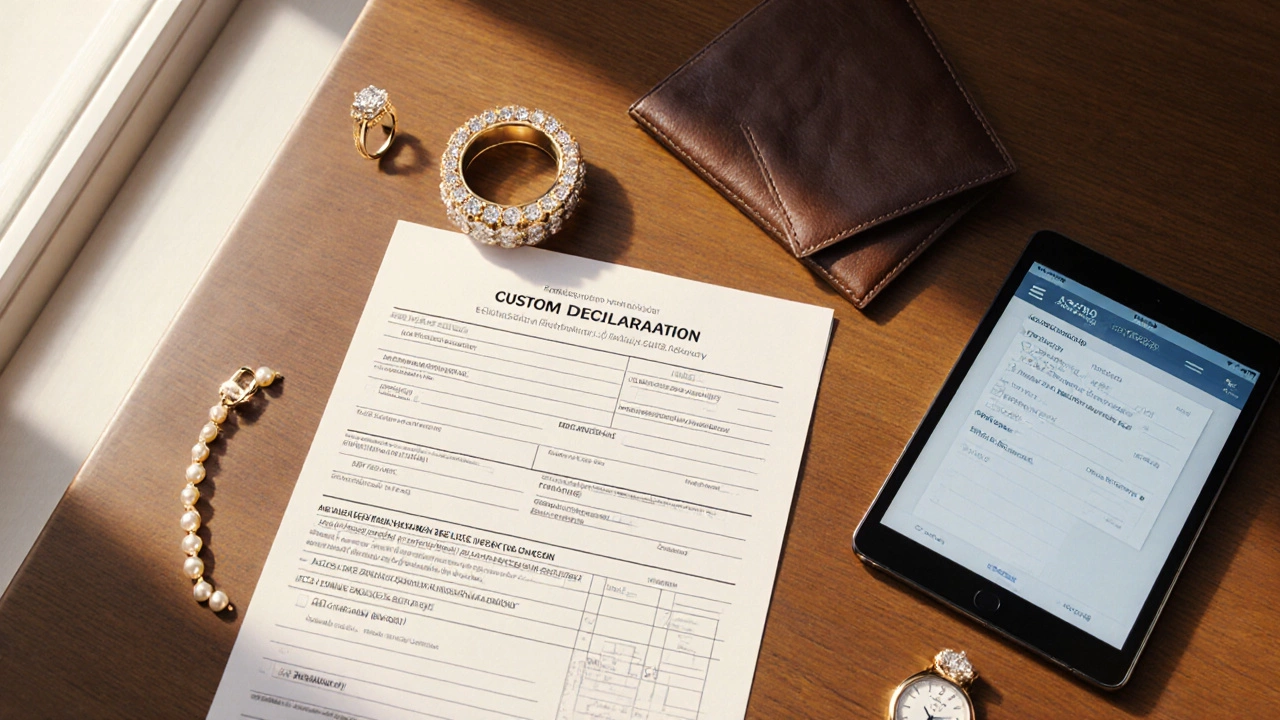Do You Need to Declare Personal Jewelry at Customs? Complete 2025 Guide

Jewelry Declaration Calculator
Calculate Your Jewelry Declaration Needs
Enter the total value of your jewelry and select your destination to see if you need to declare it at customs.
Declaration Result
Imagine stepping off a plane, only to have the customs officer ask you about that pricey necklace you thought was just a souvenir. In 2023, U.S. officials seized over $1.2million worth of undeclared jewelry in a single month. If you’ve ever wondered whether you need to put your bling on the customs form, this guide clears the fog.
What Counts as Personal Jewelry?
Personal jewelry is any ornament made of precious metals, gemstones, or other valuable materials that you wear or intend to wear. It includes rings, necklaces, bracelets, watches, and even decorative hair accessories. The definition excludes costume pieces made of base metals or plastic, unless they have a high market value.
Why Customs Care About Your Bling
Customs agencies track the movement of high‑value items for three main reasons:
- To collect duties and taxes that apply when the item’s value exceeds a duty‑free threshold.
- To prevent illegal trade in stolen or protected artifacts.
- To enforce anti‑money‑laundering rules that flag large transfers of wealth across borders.
If any of those apply, you’ll be asked to declare the item.
When Declaration Is Mandatory
In most countries, you must declare personal jewelry if its total value exceeds the personal exemption limit. The limit varies by destination and by the traveler’s residency status. Below are the most common triggers:
- Combined value over the duty‑free allowance.
- Items purchased abroad that you plan to keep long‑term.
- Antique or heritage pieces that require provenance documentation.
- Luxury watches or gemstones that are considered “high‑value goods” by the customs authority.
Even if the item is a gift, you still have to declare it if it pushes you over the limit.

Value Thresholds by Region
The three biggest travel markets-United States, European Union, and United Kingdom-handle jewelry declarations slightly differently. The table below summarizes the key numbers for 2025.
| Region | Duty‑Free Threshold | Applicable Agency | Typical Duty Rate |
|---|---|---|---|
| United States | $800 for U.S. residents, $200 for non‑residents | U.S. Customs and Border Protection (CBP) | 0% up to the threshold; 5‑10% on excess value |
| European Union | €430 for air/sea travelers, €300 for other modes | European Union customs | 0% up to threshold; 2‑5% on excess |
| United Kingdom | £390 for most travelers, £270 for EU/EEA arrivals | HM Revenue & Customs (HMRC) | 0% up to threshold; 5‑20% on excess depending on item type |
Note that thresholds are per person, not per family, and they reset after each trip.
How to Fill Out a Customs Declaration Form
Most arrival forms have a section titled “Goods to Declare.” Here’s how to handle jewelry:
- Locate the line that asks for “valuables” or “personal items over $[threshold].”
- Enter the combined total value in the currency of the destination (e.g., USD for the United States).
- Provide a brief description: “14‑karat gold diamond ring - $1,200.”
- If the form is electronic, you’ll be prompted to upload a purchase receipt or appraisal.
- Keep the original receipt handy in case the officer asks for proof.
- Sign the form and keep a copy for your records.
For frequent flyers, many agencies now accept a digital “pre‑declaration” via their mobile apps. Upload your receipts ahead of time and you’ll bypass the paper form.
Quick Tips to Avoid Penalties
- Always round up the value if you’re unsure. It’s better to over‑declare than to get fined.
- Carry an official appraisal for high‑value items (over $5,000) - it speeds up clearance.
- Know the HS tariff code for jewelry (usually 7103 for gold or 7113 for silver) - customs officers may ask for it.
- Use travel insurance that covers loss or theft of valuables abroad; some policies also reimburse duty paid on undeclared items if you can prove it was an honest mistake.
- If you’re traveling with a professional customs broker, let them handle the paperwork for large shipments.
What Happens If You Forget to Declare?
Consequences differ by jurisdiction:
- United States: You may face a fine up to 10% of the value, seizure of the item, and a possible record on your customs profile.
- European Union: Penalties can reach €150 per undeclared item, plus the duty on the excess value.
- United Kingdom: HMRC can impose a “penalty surcharge” of up to 100% of the duty owed, plus possible criminal prosecution for repeat offenders.
In most cases, officers will give you a chance to declare on the spot. The key is to cooperate and present any receipts you have.
Special Cases: Antiques, Heirlooms, and High‑Value Watches
Antique jewelry (over 100years old) may be eligible for a reduced duty rate, but you’ll need provenance documentation like a museum certificate. Luxury watches often fall under a separate tariff (typically 4.5% duty in the EU) and may require serial‑number verification.
Quick Checklist Before You Pack
- Calculate the total value of all personal jewelry you’ll bring.
- Compare it against the duty‑free threshold of your destination.
- Gather purchase receipts, appraisals, or provenance papers.
- Fill out the customs declaration form accurately (or pre‑declare via the mobile app).
- Consider travel insurance that covers customs duties.
Frequently Asked Questions
Do I need to declare cheap costume jewelry?
Generally no, as long as the combined value stays below the duty‑free threshold and the pieces are made of non‑precious materials. However, if a costume piece contains real gems that push its value up, you must declare it.
Can I bring wedding‑band jewelry without declaring?
If the band’s value is under the threshold, you can keep it duty‑free. Many travelers treat wedding rings as personal effects, but you should still note them on the form if you’re close to the limit.
What is the best way to prove the value of my jewelry?
Official appraisals from reputable jewelers, original purchase receipts, or insurance valuation reports are accepted worldwide. Keep a digital copy on your phone as a backup.
Do I pay duty on jewelry I’m selling abroad?
Yes. If the sale is considered an export, you may need to file a customs export declaration and pay any applicable duties on the transaction. Some countries offer a refund of duty if you provide proof of export.
Is there a difference for “personal use” vs. “gift” jewelry?
No. Customs looks at the total monetary value regardless of intent. A gift that pushes you over the threshold still needs to be declared.
Can I ship my jewelry separately to avoid declaration?
Shipping the item as cargo still requires a customs entry, and the duty‑free allowance applies to the total value you bring into the country, whether in luggage or as freight.
What if I’m a dual citizen traveling between my two countries?
You must abide by the rules of the country you are entering, not the one you’re leaving. Dual citizenship does not grant a higher exemption.
declare jewelry customs correctly, and you’ll enjoy your trip without a surprise at the border.